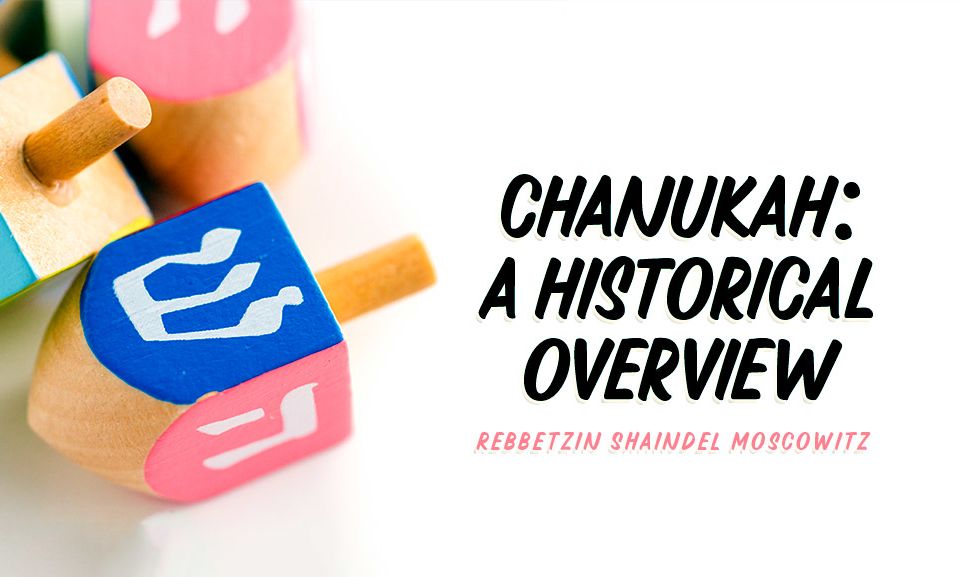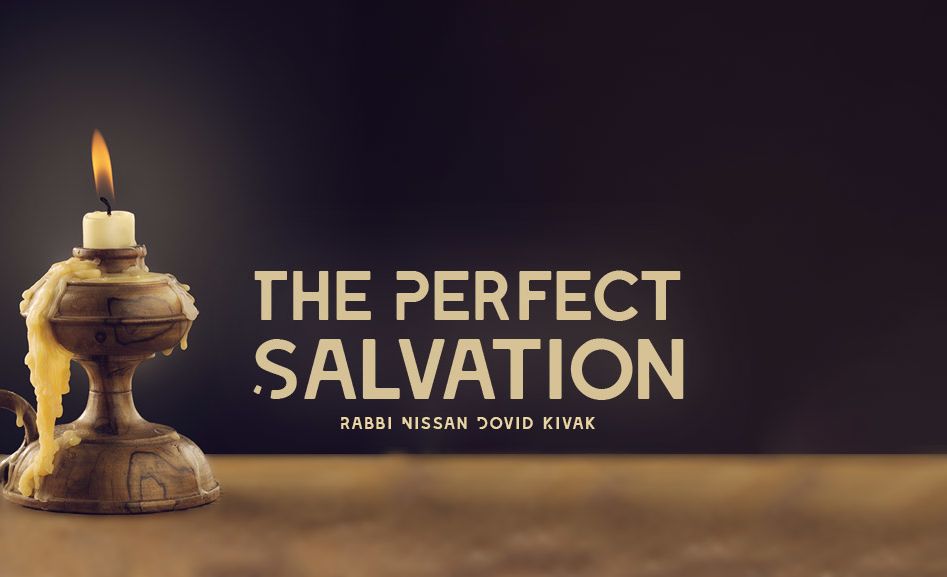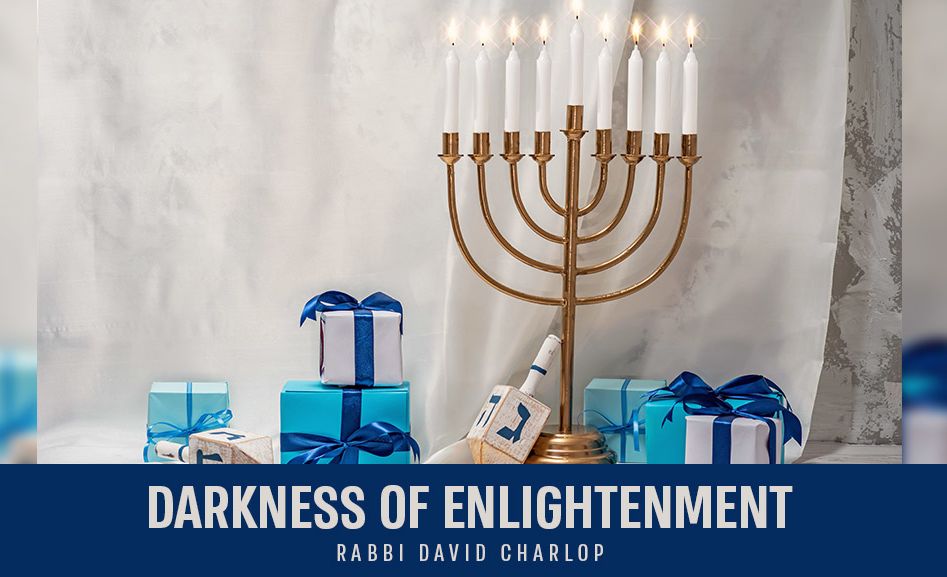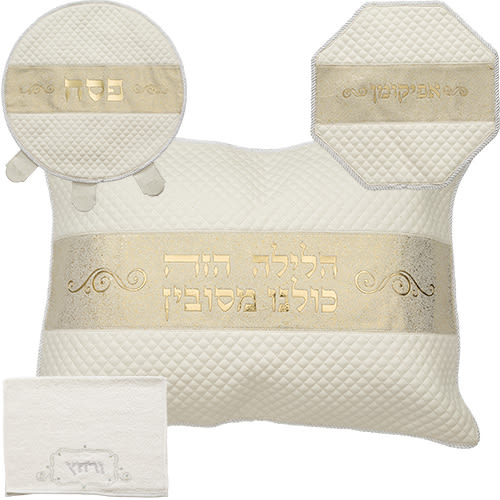
Chanukah: A Historical Overview
When the Greeks came to power they introduced a new religion that deified man, whom they considered the supreme being...

Chanukah is a Yom Tov lepirsomei nisoh, of publicizing what happened in days of old. In those days, a few weak Jews were able to vanquish their mighty enemy, but I feel that it is as applicable today as it was then – the miracle in our generation being that Klal Yisroel was able to rise up from the ashes of the holocaust – in these days!
And more than that, throughout the generations, the little Yid, always victimized has stood valiantly against the whole world…… and ultimately triumphed! Is that not a continuous miracle? Klal Yisroel, sometimes seemingly teetering on the brink of extinction, has always rebounded and moved quietly and steadily forward on its chosen path of following Hashem.
Let’s put the story of Chanukah into historical perspective and brush up on our history by going back in time. So far we Jews have been in four exiles:
- Egyptian exile (galut Mitzrayim)
- Babylonian exile (galut Bavel)
- Greek exile (galut Yavan)
- Roman exile (galut Edom) – our current exile and the final exile
Egyptian Exile
Our first exile was galut Mitzrayim (which we know about from the Torah in the sedrot of Vayigash through Bo). The beginning of galut Mitzrayim is reckoned from when Yaakov Avinu and his family went down to Mitzrayim at the time of a world-wide famine and lasted as we know from the Torah, for just over 210 years. The final and horrendous part of the galut only began when the last of Yaakov Avinu’s sons had died and lasted for 86 years; it concluded with yetziat Mitzrayim, and to celebrate this we have the Yom Tov of Pesach.
From Mitzrayim the Jews went into the desert and seven weeks after they had left Mitzrayim Hashem gave them the Torah at Har Sinai (Kabbalat HaTorah is marked by the Yom Tov of Shavuot).
Tabernacle in the Desert
Once the Jews had received the Torah they learned that one of the Mitzvot in the Torah is the avodah of sacrificing korbanot to Hashem. Accordingly during their second year in the desert they built a tabernacle where they were able to carry out the avodah. The tabernacle was a portable one which was dismantled each time Hashem commanded the Jews to travel, and rebuilt when they were told to rest. Altogether the Jews were in the desert for 40 years after which they entered Eretz Yisroel.In Eretz Yisroel the Jews built a “temporary” tabernacle (which was not portable) where they sacrificed korbanot, until the Beit Hamikdash, the final and permanent home for the avodat Hashem, was built. Shlomo Hamelech began building the Beit Hamikdash 440 years after the Jews entered Eretz Yisroel and it took 7 years to complete.
First Beit Hamikdash
The Beit Hamikdash, was the crowning glory of the Jews who were then at the zenith of their influence and capabilities. It existed for 410 years and was destroyed by Nebuchadnezzar, king of Bavel. (Both Batei HaMikdash were destroyed on the 9th and 10th Av, and these tragedies are commemorated by the fast of the 9th Av)[1]. After the Churban, apart from a small remnant left in Eretz Yisroel, all the remaining Jews were driven down to Bavel.The destruction of the first Beit Hamikdash by the Babylonians, who were the reigning world power at the time, was the beginning of the second exile, galut Bavel. Galut Bavel is divided into two parts:
- Babylonians were the rulers but they were overthrown by the Persians who became the new world power;
- Persians were the rulers. This part of galut Bavel lasted for about 150-200 years. It was during the Persian Empire’s reign (in the 70 years between the destruction of the first Beit Hamikdash and the building of the second) that the story of Purim took place with the miracle of Mordechai and Esther saving Klal Yisroel from Haman’s diabolical plan to annihilate all the Jews.
Seventy years after the destruction of the Beit Hamikdash the Persian king, Cyrus, allowed the Jews to rebuild it, whereupon part of the Jews living in Bavel returned to Eretz Yisroel.
But whereas the Jews had been an independent nation at the time of the first Beit Hamikdash, from the time of its destruction (apart from a short period of freedom after the story of Chanukah), they were never independent again; from then on they were always under the dominion of the ruling world-power. Even during the second Beit Hamikdash (which existed for 420 years) they were dependent on the good-will of the current rulers of Eretz Yisroel to be able to continue the avodah in the Beit Hamikdash.
With the fall of the Persian Empire, the Greeks rose to power and thus began the third exile. This was galut Yavan and it lasted for about 50-100 years and it is during this time that the story of Chanukah took place[2].
When the Greeks came to power they introduced a new religion to the world. This religion deified man who was considered the supreme being; only that which man was able to understand was valid and this gave rise to the great philosophers of that age.
Part of this religion was also the worship of beauty in all its forms but the Greeks only worshiped the outer facade of beauty; so long as an object or person was beautiful on the outside it did not matter how corrupt, deformed or empty it was within. This culture of beauty however dazzled the world and was eagerly accepted by all the nations, and Greece thus quickly became the world leader.
Only in Eretz Yisroel where the Greek religion was seen to be the antithesis of Judaism was it slow to spread. When Antiochus came to power in Greece and saw that the most of the Jews were still faithful to Hashem he grew impatient at the slow progress of Hellenization as it was called, and decided to accelerate that progress by force.
To this end, he forbade the three core mitzvot of Judaism, brit milah, Rosh Chodesh[3] and Shabbat, thus really striking at the heart of Judaism. He also turned the Beit Hamikdash into a pagan temple and defiled the keilim (utensils) there, thus making it impossible to continue carrying out the avodah.
Chashmonaim Revolt
When the situation in Eretz Yisroel had deteriorated to the extent that most Jews had converted (became Hellenists), Matitiyahu Cohen Gadol (High Priest) together with his five sons rose up to defend Judaism and fight the Greek army and the Hellenists. At the very most, there were a few thousand Chashmonaim, but as we know they fought and defeated the mighty Greek juggernaut. With this stunning conquest, the Chashmonaim freed the country from Greek oppression.[4]Once they had routed the enemy, the Chashmonaim turned their attention to rebuilding the country. Their first job was to restore the Beit Hamikdash to its former kedushah (holiness) and glory, and once that had been completed to re-instate the avodah (Divine Temple service) there.
Part of the daily avodah in the Beit Hamikdash was lighting the great menorah, but when the Chashmonaim looked for oil to light it all they found was one tiny flask of pure oil that was still intact with the seal of the Cohen Gadol; it had fallen beneath the cracks in the floor when the Greek soldiers were defiling the Beit Hamikdash.
This flask of oil was only enough to light the menorah for one day; to produce fresh oil took eight days. Even so the Chashmonaim decided not to wait but to light the menorah with what they had, and as we know this oil continued to burn for eight days until new supplies were available.
Chanukah Today
The story of Chanukah has two equally great miracles – the military victory of the weak against the mighty, and the few against the many – and the oil burning for far longer than it should have. And yet although we remember the military victory in Al Hanissim, we do not celebrate it – we only celebrate the miracle of the oil.
And the reason for this is because the military victory, however great was only the means to an end, that end being to enable Klal Yisroel to rise once again and keep the Torah and the mitzvot.
The true victory therefore was not winning a military battle, but the revival of the Torah. Torah, which is spirituality, is compared to light because it lights up our lives (enlightens us) and this is symbolized by the lights of the menorah; we celebrate the victory of the spirituality over the materialism, (which was symbolized by all the earthly pleasures of the Greek culture). It is this miracle that we celebrated then and continue to celebrate to this day – בימים ההם בזמן הזה.
But if we look around us today we will see that the battle for authentic Judaism has never ceased and still needs to be fought today. It might have started – בימים ההם – in those days, but it is still being fought – בזמן הזה – in these times.
We are still waging a war to keep out all those modern “Hellenistic” influences of the non-observant world which threaten to swamp our homes; our aim today – as it was then – is to keep our homes intact with the beauty and the light of the Torah.
Every Jewish home is a battlefield and we, the parents, are leading that battle – in particular we wives and mothers. Our husbands and fathers are the “commanders-in-chief” and “finance ministers” of each “unit” in this “army” fighting for Judaism. They devise strategies, issue the orders, draw the battle lines and pay for the war (i.e. they set up and guard the parameters of Judaism and support the family). But a commander-in-chief by definition is not usually found on the “front lines”; his place is ”behind the lines”.
It is we women who are the ”generals” out on the “battlefield” itself directing the troops and doing daily battle from morning till night. From when we wake up in the morning with modeh ani (I thank You…) and negel vasser (hand washing), till last thing at night with kriat shema al hamittah (Kriyat Shema at bedtime), we are busy “fighting” to infuse our families with true Judaism.
And it is us, the ”generals”, doing ”real-time battle” who will in the end receive the reward for training today’s youth to be tomorrow’s soldiers.
Keep up that battle for the souls of your children and don’t get tired – Hashem is with you all the way – as He was then with the Chashmonaim so He is with us now.
Because we are still deep in galut Edom it is as great a miracle today that the little flame of Judaism that was relit then is still burning brightly – and it is to your credit that it is so.
And next year when you say Al Hanissim on Chanukah include yourself amongst that army of Chashmonaim who responded to Matitiyahu’s call of “Whoever is for Hashem, let him join me!”
In the meantime I hope you enjoyed those latkes and doughnuts drowning in oil, (it’s ”good” for your cholesterol and waistline), as you take a breather in-between the ”battles”. And even if you didn’t win a reward when you played driedel, you’re still a winner all the way!
* * *
[1]We also have the fast of the 17th of Tammuz; this commemorates the first breach in the wall surrounding Yerushalayim which happened three weeks before the actual destruction of the Beit Hamikdash. We fast on that date because it was the “beginning of the end”, i.e. the beginning of the Churban (destruction).
[2]Nes Chanukah took place about 200 years after the building of the second Beit Hamikdash
[3]If we don’t know when Rosh Chodesh is we can’t keep the Yomim Tovim.
[4]This freedom didn’t last too long though; still during the time of the second Beit Hamikdash the Romans conquered Eretz Yisroel and this was the beginning of the fourth and final exile, galut Edom.











Tell us what you think!
Thank you for your comment!
It will be published after approval by the Editor.